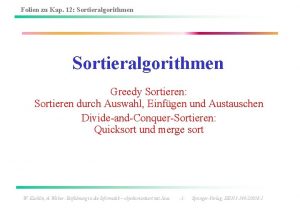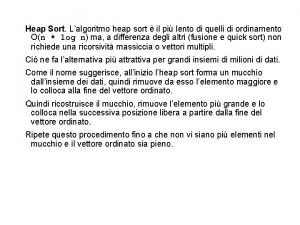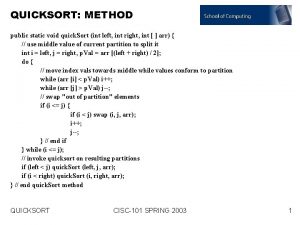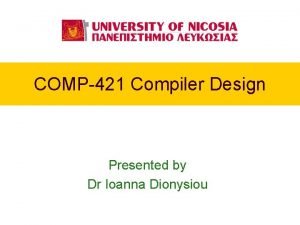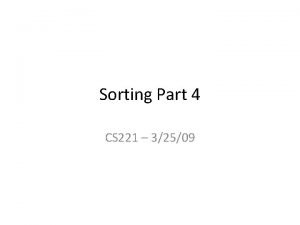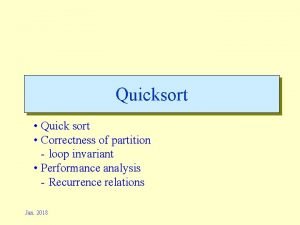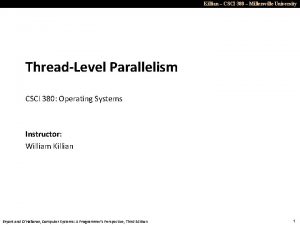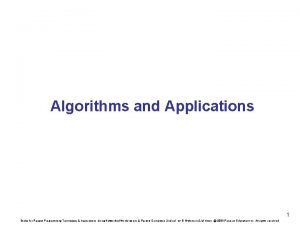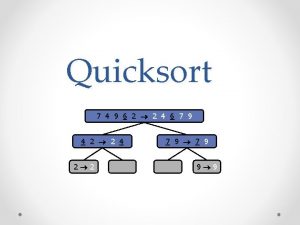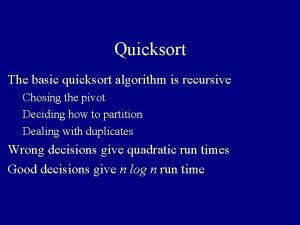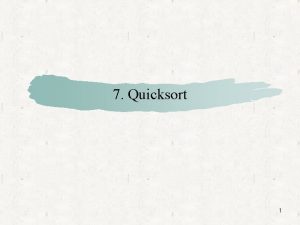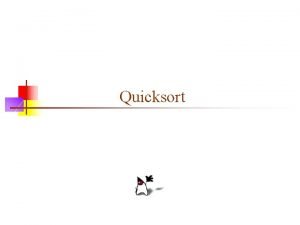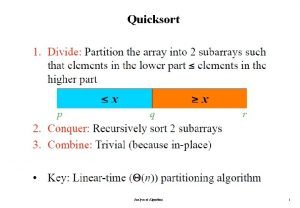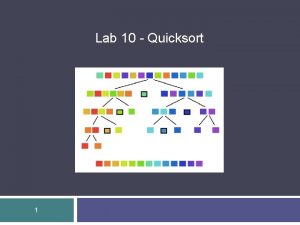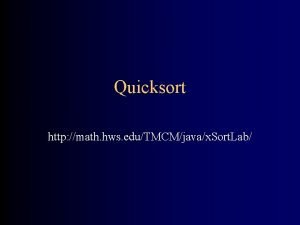Quicksort 7 4 9 6 2 2 4
















- Slides: 16

Quicksort 7 4 9 6 2 2 4 6 7 9 4 2 2 4 2 2 7 9 9 9

Brute Force – Algorithm Design Strategy • Brute force - A straightforward approach to solve a problem based directly on problem statement. o o Not particularly clever or efficient Usually intellectually easy to apply Use the force of the computer Still an important algorithm design strategy • Example Brute force sorts: o Selection sort o Bubble sort o Insertion sort Quicksort

Divide and Conquer –Algorithm Design Strategy • Divide and Conquero Divide - A problem is divided into smaller instances of the same problem, ideally the same size. • Smaller instances are solved(typically using recursion) • AKA recur o Conquer – Solutions to smaller instances of problems are combined to obtain a solution to original problem. • Example Divide and Conquer sorts: o Merge sort o Quick sort Quicksort

Outline • Quick-sort o o Algorithm Partition step Quick-sort tree Execution example • Average case intuition Quicksort

Quick-Sort • Randomized Quick-sorting algorithm is based on the divide-and-conquer paradigm: x o Divide: pick a random element x (called pivot) and partition S into • L elements less than x • E elements equal x • G elements greater than x o Recur: sort L and G o Conquer: join L, E and G Quicksort x L E x G

Quick-Sort Tree • An execution of quick-sort is depicted by a binary tree o Each node represents a recursive call of quicksort and stores • Unsorted sequence before the execution and its pivot • Sorted sequence at the end of the execution o The root is the initial call o The leaves are calls on subsequences of size 0 or 1 7 4 9 6 2 2 4 6 7 9 4 2 2 4 2 2 Quicksort 7 9 9 9

Execution Example • Pivot selection 7 2 9 43 7 6 1 1 2 3 4 6 7 8 9 7 2 9 4 2 4 7 9 2 2 9 4 4 9 9 9 Quicksort 3 8 6 1 1 3 8 6 4 4 3 3 8 8

Execution Example (cont. ) • Partition, recursive call, pivot selection 7 2 9 4 3 7 6 1 1 2 3 4 6 7 8 9 2 4 3 1 2 4 7 9 2 2 9 4 4 9 9 9 Quicksort 3 8 6 1 1 3 8 6 4 4 3 3 8 8

Execution Example (cont. ) • Partition, recursive call, base case 7 2 9 43 7 6 1 1 2 3 4 6 7 8 9 2 4 3 1 2 4 7 1 1 9 4 4 9 9 9 Quicksort 3 8 6 1 1 3 8 6 4 4 3 3 8 8

Execution Example (cont. ) • Recursive call, …, base case, join 7 2 9 43 7 6 1 1 2 3 4 6 7 8 9 2 4 3 1 1 2 3 4 1 1 4 3 3 4 9 9 Quicksort 3 8 6 1 1 3 8 6 4 4 3 3 8 8

Execution Example (cont. ) • Recursive call, pivot selection 7 2 9 43 7 6 1 1 2 3 4 6 7 8 9 2 4 3 1 1 2 3 4 1 1 4 3 3 4 9 9 Quicksort 7 9 7 1 1 3 8 6 4 4 8 8 9 9

Execution Example (cont. ) • Partition, …, recursive call, base case 7 2 9 43 7 6 1 1 2 3 4 6 7 8 9 2 4 3 1 1 2 3 4 1 1 4 3 3 4 9 9 Quicksort 7 9 7 1 1 3 8 6 4 4 8 8 9 9

Execution Example (cont. ) • Join, join 7 2 9 4 3 7 6 1 1 2 3 4 6 7 7 9 2 4 3 1 1 2 3 4 1 1 4 3 3 4 9 9 Quicksort 7 9 7 17 7 9 4 4 8 8 9 9

Worst-case Running Time • The worst case for quick-sort occurs when the pivot is the unique minimum or maximum element • Either L and G has size n - 1 and the other has size 0 • The running time is proportional to the sum n + (n - 1) + … + 2 + 1 • Thus, the worst-case running time of quick-sort is O(n 2) depth time 0 n 1 n-1 … Quicksort … … n-1 1

Expected Running Time • Consider a recursive call of quick-sort on a sequence of size s o Good call: the sizes of L and G are each less than 3 s/4 o Bad call: one of L and G has size greater than 3 s/4 7 2 9 43 7 6 19 7 1 1 2 4 3 1 1 7294376 Good call Bad call • A call is good with probability 1/2 of the possible pivots cause good calls: 1 2 3 4 5 6 7 8 9 10 11 12 13 14 15 16 Bad pivots Quicksort Good pivots Bad pivots

Quicksort Implementation void quick. Sort( vector<Item>& v, int a, int b ) { // Let m be a guess as to the index of the median of the // items in v in the range v[a]. . . v[b] int M = v[m]; swap( v[m], v[b] ) int L = a; int R = b-1; while ( L <= R ) { while ( v[L] < M ) ++L; while ( v[R] > M ) --R; if ( L < R ) swap( v[L], v[R] ); } swap ( v[b], v[R] ); // putting M in between quick. Sort( v, a, L ); quick. Sort( v, R+1, b ); } Quicksort
 Heapsort vs quicksort
Heapsort vs quicksort Verilog bubble sort
Verilog bubble sort Quicksort
Quicksort Quick sort on linked list
Quick sort on linked list Quicksort duplicate elements
Quicksort duplicate elements Sortieralgorithmen java quicksort
Sortieralgorithmen java quicksort Algoritmo quicksort
Algoritmo quicksort Trace quicksort algorithm
Trace quicksort algorithm Storage organization in compiler design
Storage organization in compiler design Bucket sort animation
Bucket sort animation Loop invariant quicksort
Loop invariant quicksort Quicksort visualized
Quicksort visualized Parallel quicksort
Parallel quicksort Quick sort worst case
Quick sort worst case Quicksort
Quicksort Quicksort recursive
Quicksort recursive Why is merge sort n log n
Why is merge sort n log n





